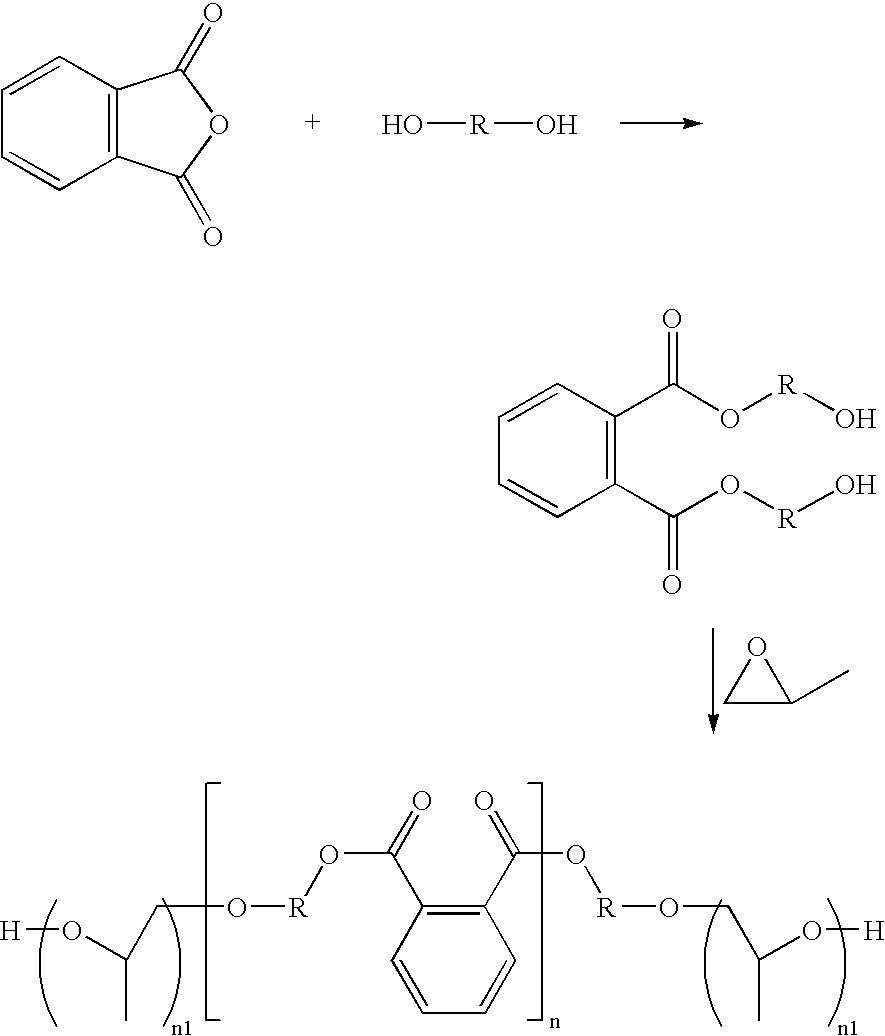Phthalic anhydride based polyester-ether polyols and double metal cyanide catalyst system for preparing same
a technology of polyester ether and catalyst system, which is applied in the field of polyethylene ether polyols, can solve the problems of urethane coating, loss of desirable physical properties, and more susceptible hydrolysis, and achieves the effects of reducing viscosity, improving handling ease, and high desirable properties
- Summary
- Abstract
- Description
- Claims
- Application Information
AI Technical Summary
Benefits of technology
Problems solved by technology
Method used
Image
Examples
example 1
Preparation of Polyester Polyol C (comparative example; STEPANPOL® PS-2002)
[0160] PS-2002 is prepared as the condensation product of about 45% diethylene glycol (DEG) and 55% phthalic anhydride. Into a three gallon kettle is charged 4500 g of DEG and 5500 g PA. This mixture is heated to about 180° C. for four hours under a nitrogen atmosphere. After four hours the temperature is raised to about 180-200° C., and approximately 500 ppm of catalyst tetrabutyl titinate (Tyzor TBT, DuPont) is added to the kettle. The pressure is reduced in the kettle and removal the water by-product is begun under vacuum. The water is completely removed after about 24 hours of reaction at about 180-200° C. under vacuum. The final polyester polyol is characterized by a hydroxyl number of 190-200 mg KOH / g and has a Brookfield viscosity of about 20,000-30,000 cPs at 25° C. and an acid value less than 1 mg KOH / g.
example 2
Preparation of Polyester-Ether Polyol D (propoxylated ortho-phthalate diethylene glycol ester)
[0161] Into a two gallon steel pressure Chemineer kettle is charged 3678 grams StepanPolâ PS-2002 and 155 grams of crushed potassium hydroxide. The mixture is blended under a nitrogen blanket for 2 hours at 120° C. A total of 7,060 grams of propylene oxide is added under a pressure of <42 psig over three hours at a temperature of about 120-125° C. A total of 500 grams of this crude product is then transferred to a flask where it is then heated to about 100° C. and degassed to remove unreacted propylene oxide. The material is then finished / neutralized: To the remaining warm mixture, 1.5 grams of Magnesol HMR-LS (The Dallas Group) is added and the mixture is then stirred at about 100-120° C. for four hours. The resulting mixture is allowed to stand warm (80° C.) for approximately 12 hours and the product is decanted and filtered through a vacuum flask equipped with a Buchner funnel and a #4 ...
example 3
Preparation of Polyester-Ether Polyol E (Propoxylated Ortho-Phthalate Diethylene Glycol Ester)
[0162] Polyol E is prepared in a similar manner to that of polyol D, except the amounts of materials used are 14.5 g KOH, 2890 g, StepanPol PS-2002 and 6010 g propylene oxide. Analysis of polyol E gave the following properties:
OH value =59.4 mg KOH / g (ASTM E 222 method)Dynamic viscosity =1,400 cP @ 25° C. (Brookfleld, #31 spindle)% Propylene oxide =69% by weight% Moisture =0.023% (ASTM D 4672 method)
PUM
 Login to View More
Login to View More Abstract
Description
Claims
Application Information
 Login to View More
Login to View More - R&D
- Intellectual Property
- Life Sciences
- Materials
- Tech Scout
- Unparalleled Data Quality
- Higher Quality Content
- 60% Fewer Hallucinations
Browse by: Latest US Patents, China's latest patents, Technical Efficacy Thesaurus, Application Domain, Technology Topic, Popular Technical Reports.
© 2025 PatSnap. All rights reserved.Legal|Privacy policy|Modern Slavery Act Transparency Statement|Sitemap|About US| Contact US: help@patsnap.com



